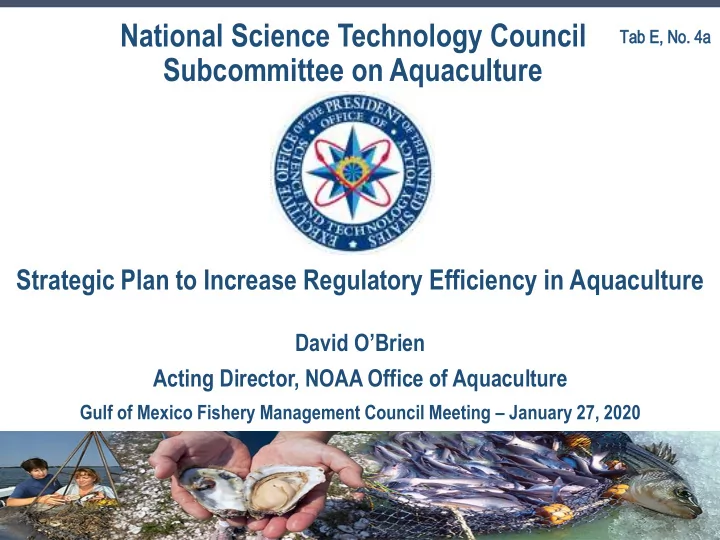

National Science Technology Council Tab E, No. 4a Subcommittee on Aquaculture Strategic Plan to Increase Regulatory Efficiency in Aquaculture David O’Brien Acting Director, NOAA Office of Aquaculture Gulf of Mexico Fishery Management Council Meeting – January 27, 2020
NSTC Subcommittee on Aquaculture • The Subcommittee on Aquaculture (SCA) serves as the federal interagency coordinating group to increase the overall effectiveness and productivity of federal aquaculture research, regulation, technology transfer, and assistance programs. The SCA was established under the National Aquaculture Act • of 1980 and operates under the White House’s Office of Science and Technology Policy’s National Science and Technology Council (NSTC). In 2018, the SCA established a Science Planning Task Force • and a Regulatory Efficiency Task Force to improve interagency coordination on federal regulations and research, respectively.
Overview The Regulatory Efficiency Task Force of the Subcommittee • on Aquaculture (SCA) has prepared a draft Strategic Plan to Enhance Regulatory Efficiency in Aquaculture (Plan). • The Plan outlines actions federal agencies can take to improve the efficiency, predictability and timeliness and to reduce costs of reviewing, approving, monitoring, and enforcing permits and other regulatory requirements. Actions would be executed within existing statutory • authorities and budgetary resources.
Overview • The Plan addresses: Efficiencies in Aquaculture Permitting and Authorization • Programs • Aquatic Animal Health Management Tools for Aquaculture Regulatory Management • • The SCA sought public comment on a Plan outline in Fall 2019. The Plan will likely be made available for public comment by early Spring 2020.
Permitting and Authorization Programs Five priority areas to improve efficiency and predictability of aquaculture permitting in state and federal waters: 1. Expanded range of activities authorized under general permits and through programmatic consultations. 2. Maintain and update state-by-state information on shellfish farming requirements.
Permitting and Authorization Programs 3. Establish regional interagency coordinating groups and process for implementation of permits and authorizations for aquaculture in federal waters. Includes consideration of Aquaculture Management Areas • 4. Improve aquaculture-specific outreach to the NPDES program and continue providing information on water quality risks associated with aquatic animal production. 5. Establish a clear and transparent federal process for ensuring the safety of molluscan shellfish grown in federal waters.
Aquatic Animal Health Management Actions focus on aquatic animal health, food safety, and international trade. Aquatic Animal and Aquaculture Health 1. Sunset current National Aquatic Animal Health Plan or redraft to incorporate Commercial Aquaculture Health Program Standards. 2. Improve diagnostics and inspections of aquatic animals.
Aquatic Animal Health Management Aquatic Animal and Aquaculture Health (continued): 3. Improve efficiencies for drug approvals and licensing of biologics for aquatic animals and food additive approvals for use in aquaculture feeds. 4. Review and clarify requirements for domestic movement of live animals across state lines. 5. Develop surveillance strategies and emergency response plans for priority aquatic animal pathogens.
Aquatic Animal Health Management International Trade 1. Clarify and define federal agency roles in aquatic animal health attestations/certifications and import/export of aquatic animals. 2. Establish standard operating procedures for agency communication and points of contact for federal and state agencies involved in the movement (import/export) of aquatic animals.
Science to Support Regulatory Management Federal agencies will continue to develop science-based tools and information are necessary to support regulatory decisions and management oversight: 1. Identify additional science information needed federal state permit reviews, consultations, and policy decisions. 2. Refine and test science tools for regulation and management. 3. Implement coordinated priority actions in tool development.
Recommend
More recommend